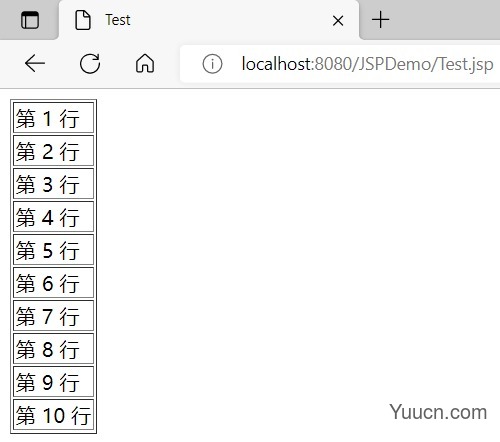目录
-
JSTL 标签库
- JSTL 标签库的使用步骤
-
core 核心库使用
- <c:set /> (使用很少)
- <c:if />
- <c:choose><c:when><c:otherwise>标签
- <c:forEach />
JSTL 标签库
JSTL 标签库 全称是指 JSP Standard Tag Library JSP 标准标签库。是一个不断完善的开放源代码的 JSP 标
签库。
EL 表达式主要是为了替换 jsp 中的表达式脚本,而标签库则是为了替换代码脚本。这样使得整个 jsp 页面
变得更佳简洁。
JSTL 由五个不同功能的标签库组成。
| 功能范围 | URI | 前缀 |
|---|---|---|
| 核心 标签库-- 重点 | http://java.sun.com/jsp/jstl/core | c |
| 格式化 | http://java.sun.com/jsp/jstl/fmt | fmt |
| 函数 | http://java.sun.com/jsp/jstl/functions | fn |
| 数据库(不使用) | http://java.sun.com/jsp/jstl/sql | sql |
| XML(不使用) | http://java.sun.com/jsp/jstl/xml | x |
在 jsp 标签库中使用 taglib 指令引入标签库
CORE 标签库
<%@ taglib prefix="c" uri="http://java.sun.com/jsp/jstl/core" %>
XML 标签库
<%@ taglib prefix="x" uri="http://java.sun.com/jsp/jstl/xml" %>
FMT 标签库
<%@ taglib prefix="fmt" uri="http://java.sun.com/jsp/jstl/fmt" %>
SQL 标签库
<%@ taglib prefix="sql" uri="http://java.sun.com/jsp/jstl/sql" %>
FUNCTIONS 标签库
<%@ taglib prefix="fn" uri="http://java.sun.com/jsp/jstl/functions" %>
JSTL 标签库的使用步骤
1、先导入 jstl 标签库的 jar 包。
-
taglibs-standard-impl-1.2.5.jar
-
taglibs-standard-spec-1.2.5.jar
下载地址https://tomcat.apache.org/download-taglibs.cgi
2、第二步,使用 taglib 指令引入标签库。
<%@ taglib prefix="c" uri="http://java.sun.com/jsp/jstl/core" %>
core 核心库使用
<c:set /> (使用很少)
作用:set 标签可以往域中保存数据
<body>
<%--
i.<c:set />
作用: set 标签可以往域中保存数据
域对象 .setAttribute(key,value);
scope 属性设置保存到哪个域
page 表示 PageContext 域(默认值)
request 表示 Request 域
session 表示 Session 域
application 表示 ServletContext 域
var 属性设置 key 是多少
value 属性设置值
--%>
保存之前:${ sessionScope.abc } <br>
<c:set scope="session" var="abc" value="abcValue"></c:set>
<%-- <c:set scope="session" var="abc" value="abcValue"/>--%>
保存之后:${ sessionScope.abc } <br>
</body>
结果:

<c:if />
if 标签用来做 if 判断。
例:
<body>
<%--
ii.<c:if />
if 标签用来做 if 判断。
test 属性表示判断的条件(使用 EL 表达式输出)
--%>
<c:if test="${ 12 == 12 }">
<h1>12 等于 12</h1>
</c:if>
<c:if test="${ 12 != 12 }">
<h1>12 不等于 12</h1>
</c:if>
</body>
结果:

<c:choose><c:when><c:otherwise>标签
作用:多路判断。跟 switch ... case .... default 非常接近
<body>
<%--
<c:choose> <c:when> <c:otherwise> 标签
作用:多路判断。跟 switch ... case .... default 非常接近
choose 标签开始选择判断
when 标签表示每一种判断情况
test 属性表示当前这种判断情况的值
otherwise 标签表示剩下的情况
<c:choose> <c:when> <c:otherwise> 标签使用时需要注意的点:
1 、标签里不能使用 html 注释,要使用 jsp 注释
2 、 when 标签的父标签一定要是 choose 标签
--%>
<%
request.setAttribute("score", 92);
%>
<c:choose>
<%-- 这是 html 注释 --%>
<c:when test="${ requestScope.score > 90 }">
<h2>优秀</h2>
</c:when>
<c:when test="${ requestScope.score > 80 }">
<h2>良好</h2>
</c:when>
<c:when test="${ requestScope.score > 60 }">
<h2>及格</h2>
</c:when>
<c:otherwise>
<c:choose>
<c:when test="${requestScope.score > 60}">
<h3>大于 60</h3>
</c:when>
<c:when test="${requestScope.score > 50}">
<h3>大于 50</h3>
</c:when>
<c:when test="${requestScope.score > 40}">
<h3>大于 40</h3>
</c:when>
<c:otherwise>
其他小于 40
</c:otherwise>
</c:choose>
</c:otherwise>
</c:choose>
</body>
结果:

<c:forEach />
作用:遍历输出使用。
-
遍历 1 到 10 ,输出
示例代码:<body> <%--1. 遍历 1 到 10 ,输出 begin 属性设置开始的索引 end 属性设置结束的索引 var 属性表示循环的变量 ( 也是当前正在遍历到的数据 ) for (int i = 1; i < 10; i++) --%> <table border="1"> <c:forEach begin="1" end="10" var="i"> <tr> <td>第${i}行</td> </tr> </c:forEach> </table> </body>
-
遍历 Object 数组
示例代码:<body> <%-- 2. 遍历 Object 数组 for (Object item: arr) items 表示遍历的数据源(遍历的集合) var 表示当前遍历到的数据 --%> <% request.setAttribute("arr", new String[]{"18736635442","18688886666","18699998888"}); %> <c:forEach items="${ requestScope.arr }" var="item"> ${ item } <br> </c:forEach> </body>

-
遍历 Map 集合
示例代码:
<body> <% Map<String,Object> map = new HashMap<String, Object>(); map.put("key1", "value1"); map.put("key2", "value2"); map.put("key3", "value3"); // for ( Map.Entry<String,Object> entry : map.entrySet()) { // } request.setAttribute("map", map); %> <c:forEach items="${ requestScope.map }" var="entry"> <h5>${entry.key} = ${entry.value}</h5> </c:forEach> </body>结果:

-
遍历 List 集合---list 放 中存放 Student 类 , 有属性 : 编号 , 用户名 , 密码 , 年龄 ,
电话信息
Student 类:public class Student { //4. 编号,用户名,密码,年龄,电话信息 private Integer id; private String username; private String password; private Integer age; private String phone; }jsp:
<body> <%--4. 遍历 List 集合 ---list 中存放 Student 类,有属性:编号,用户名,密码,年龄,电话信息 --%> <% List<Student> studentList = new ArrayList<Student>(); for (int i = 1; i <= 10; i++) { studentList.add(new Student(i,"username"+i ,"pass"+i,18+i,"phone"+i)); } request.setAttribute("stus", studentList); %> <table> <tr> <th>编号</th> <th>用户名</th> <th>密码</th> <th>年龄</th> <th>电话</th> <th>操作</th> </tr> <%-- items 表示遍历的集合 var 表示遍历到的数据 begin 表示遍历的开始索引值 end 表示结束的索引值 step 属性表示遍历的步长值 varStatus 属性表示当前遍历到的数据的状态 for ( int i = 1; i < 10; i+=2 ) --%> <c:forEach begin="1" end="10" step="2" varStatus="status" items="${requestScope.stus}" var="stu"> <tr> <td>${stu.id}</td> <td>${stu.username}</td> <td>${stu.password}</td> <td>${stu.age}</td> <td>${stu.phone}</td> <td>添加、删除</td> </tr> </c:forEach> </table> </body>
欢迎关注公众号:愚生浅末
如图片失效等情况请参阅头条文章:https://www.toutiao.com/article/7137198159868002857/